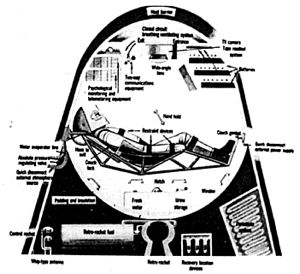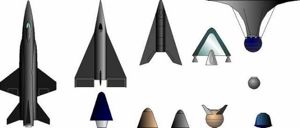
Home - Search - Browse - Alphabetic Index: 0- 1- 2- 3- 4- 5- 6- 7- 8- 9
A- B- C- D- E- F- G- H- I- J- K- L- M- N- O- P- Q- R- S- T- U- V- W- X- Y- Z
Martin Project 7969
 Proj 7969 Martin Credit: NASA |
Status: Study 1958. Gross mass: 1,600 kg (3,500 lb). Height: 4.26 m (13.97 ft).
Tracking would use the Minitrack System and deorbit would be accomplished by a retrorocket producing a 150 m/sec delta-v. Spacecraft attitude control was by rocket thrusters. The spacecraft was fully automatic and the pilot was only a passenger. Maximum G-forces during re-entry were 8-15 g's and an ablative heat shield was proposed. In case of booster failure during ascent to orbit the capsule would be ejected. The spacecraft had a ballistic coefficient (m/CdA) of 500 kg per square meter. Landing precision was within a 160 x 160 km footprint. It was expected that a first manned orbital flight could be achieved 30 months after a go-ahead.
Family: Manned spacecraft. Country: USA. Launch Vehicles: Titan, Titan I. Agency: USAF, Martin. Bibliography: 26, 483, 59.
Back to top of page
Home - Search - Browse - Alphabetic Index: 0- 1- 2- 3- 4- 5- 6- 7- 8- 9
A- B- C- D- E- F- G- H- I- J- K- L- M- N- O- P- Q- R- S- T- U- V- W- X- Y- Z
© 1997-2019 Mark Wade - Contact
© / Conditions for Use
